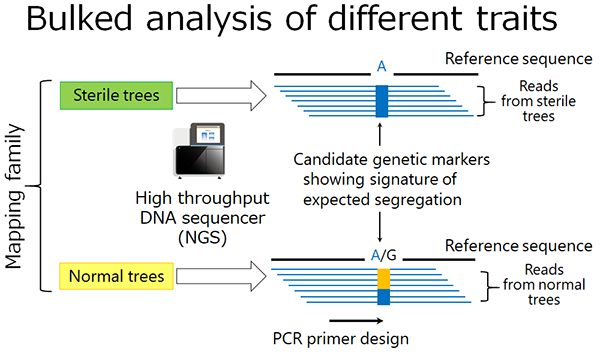Home > Research > Research Results > Research Results 2019 > Accelerate selection of pollen-free cedars by efficiently developing genetic markers related to male sterile trait
Update:May 17, 2019
Main content starts here.
Accelerate selection of pollen-free cedars by efficiently developing genetic markers related to male sterile trait
| Article title |
Scanning RNA-Seq and RAD-Seq approach to develop SNP markers closely linked to MALE STERILITY 1 (MS1) in Cryptomeria japonica D. Don |
|---|---|
| Author (affiliation) |
Saneyoshi Ueno (a), Kentaro Uchiyama (a), Yoshinari Moriguchi (b), Tokuko Ujino-Ihara (a), Asako Matsumoto (a), Fu-Jin Wei (a), Maki Saito (c), Yumi Higuchi (d), Norihiro Futamura (a), Hiroyuki Kanamori (e), Yuichi Katayose (e), Yoshihiko Tsumura (a,f) (a) Department of Forest Molecular Genetics and Biotechnology, FFPRI, Tsukuba, Ibaraki, Japan. (b) Graduate School of Science and Technology, Niigata University, Niigata, Japan. (c) Toyama Prefectural Agricultural Forestry and Fisheries Research Center, Forestry Research Institute, Nakashinkawagun, Toyama, Japan. (d) Niigata Prefectural Forest Research Institute, Murakami, Niigata, Japan (retired). (e) National Institute of Agrobiological Sciences, Owashi, Tsukuba, Ibaraki, Japan. (f) Faculty of Life and Environmental Sciences, University of Tsukuba, Tsukuba, Ibaraki, Japan. |
| Publication Journal |
Breeding Science 69 (1), March 2019 DOI:10.1270/jsbbs.17149( External link ) |
| Content introduction |
An organism’s traits are determined by genes. In order to search for genes related to a certain trait, it has conventionally been necessary to analyze a large number of genetic markers, using about 100–200 individuals to find markers that strongly correlate with the trait. In the present study, we analyzed a large amount of DNA sequence data obtained from a high throughput DNA sequencer (NGS) to map the male sterility trait in Cryptomeria japonica D. Don. Data were collected from both bulked male sterile and normal trees, and an index was calculated to indicate the degree of correlation between the sequence and the male sterility trait. Based on the index, genetic markers related to male sterility were developed and applied to the mapping family. This result shows how to efficiently develop genetic markers related to male sterility traits. Moreover, this technique can be widely applied to the development of markers related to other qualitative traits.
Note on genetic markers: Genetic markers are helpful in tracking the transmission of genes from parents to children. For example, human blood types can be used as genetic markers. In recent years, differences in DNA sequences have been widely used as genetic markers.
Figure: A schematic representation on the efficient development of genetic markers associated with male sterility traits. |
Copyright © Forest Research and Management Organization. All rights reserved.

